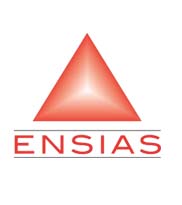- Accueil
-
L'Ecole
-
FORMATIONS
-
FORMATION INGENIEUR
-
Nouvelles filières offertes 2021
- Ingénierie Intélligence Artificielle (2IA)
- Smart Supply Chain & Logistics (2SCL)
- Business Intelligence & Analytics (BI&A)
- Génie de la Data (GD)
- Génie Logiciel (GL)
- Ingénierie Digitale pour la Finance (IDF)
- Smart System Engineering (SSE)
- Ingénierie en Data Science and IOT (IDSIT)
- Sécurité des Systèmes d’Information (SSI)
- REGLEMENT DES ETUDES DE L’ENSIAS CYCLE INGENIEUR
-
Nouvelles filières offertes 2021
-
FORMATION MASTER
- Master de recherche Bioinformatique et Modélisation des Systèmes Complexes Appliquée à la Santé.
- Master Internet des Objets : Logiciel et Analytique (MIOLA)
- Master Recherche en Science de Données et Big Data
- Nouveau Master de Recherche en Sécurité Systèmes et Services (M3S)
- NOUVEAU Master de Recherche : Cloud and high Performance Computing (CLOUDHPC)
-
FORMATION INGENIEUR
- FORMATION CONTINUE
-
Recherche
- INTERNATIONAL
- ENTREPRISES
- VIE ESTUDIANTINE
- BIBLIOTHEQUE
LES DERNIÈRES INFORMATIONS
On the Secrecy Analysis of Dual-Hop SWIPT-based Multi-Source Underlay Cognitive Radio Networks
| Titre | On the Secrecy Analysis of Dual-Hop SWIPT-based Multi-Source Underlay Cognitive Radio Networks |
| Publication Type | Journal Article |
| Year of Publication | 2022 |
| Authors | Bouanani, FE, Lahmar, I, Ismaili, ZEAA, Qaraqe, KA |
| Journal | IEEE Transactions on Cognitive Communications and Networking |
| Pagination | 1-1 |
| Mots-clés | Channel state information, Cognitive radio, Cognitive radio network, Communication channels (information theory), Dual-hop networks, Eavesdropping, Energy harvesting, Information and power transfers, Intelligent systems, Intercept probability, Intercept probability network, Interference, Internet protocols, Monte Carlo methods, Network layers, Network security, Physical layer security, Radio systems, Rayleigh fading, Receiver, Relay, Secure communication, Signal receivers, Signal to noise ratio, Simultaneous wireless information and power transfer, Underlay cognitive radio network, Underlay cognitive radios |
| Abstract | This paper investigates the intercept probability (IP) performance for a dual-hop multi-secondary user (SU) underlay cognitive-radio networks. Whereby, the relay R is self-powered by harvesting energy from secondary sources using the time switching variant (TS) of simultaneous wireless information and power transfer (SWIPT) protocol. Single-antenna SUs are transmitting data to multi-antennas end-user D, performing maximal-ratio combining (MRC) diversity technique, through R in presence of (i) a primary network composed of a primary transmitter (PUt) and receiver (PUr) pair, and (ii) a passive eavesdropper at each hop (i.e., E1 and E2), attempting to overhear the communication. Moreover, we suppose that the second eavesdropper has multiple antennas and employs the MRC technique, that the relay employs the Decode-and-Forward relaying protocol, that the two hops are subject to the Rayleigh fading model, and that the channel state information is fully known at both D and E2. Because of the underlying strategy, the SUs are constantly modifying their transmit powers to prevent interference with primary users. A closed-form expression of the IP is obtained by taking into consideration the correlation between the secrecy capacities for both hops. The impact of other essential factors on IP, such as the transmit power of sources, the fading severity parameter, and the maximum tolerable interference power (MTIP), is also investigated. Specifically, we want to know if the energy harvester (i.e., relay) might improve the security of such a system even more for low MTIP or transmit power of SUs. Monte Carlo simulations verify all of the obtained results, and valuable insights into the secrecy of the considered system are achieved. IEEE |
| URL | https://www.scopus.com/inward/record.uri?eid=2-s2.0-85141508701&doi=10.1109%2fTCCN.2022.3217780&partnerID=40&md5=79af2dcf046827ee8c634d461186ab82 |
| DOI | 10.1109/TCCN.2022.3217780 |
Revues:
LIENS UTILES
Localisation
Contactez-nous
ENSIAS
 Avenue Mohammed Ben Abdallah Regragui, Madinat Al Irfane, BP 713, Agdal Rabat, Maroc
Avenue Mohammed Ben Abdallah Regragui, Madinat Al Irfane, BP 713, Agdal Rabat, Maroc
![]() Télécopie : (+212) 5 37 68 60 78
Télécopie : (+212) 5 37 68 60 78
![]() Secrétariat de direction : 06 61 48 10 97
Secrétariat de direction : 06 61 48 10 97
Secrétariat général : 06 61 34 09 27
Service des affaires financières : 06 61 44 76 79
Service des affaires estudiantines : 06 62 77 10 17 / n.mhirich@um5s.net.ma
Résidences : 06 61 82 89 77
Education - This is a contributing Drupal Theme
Design by WeebPal.
Design by WeebPal.



































